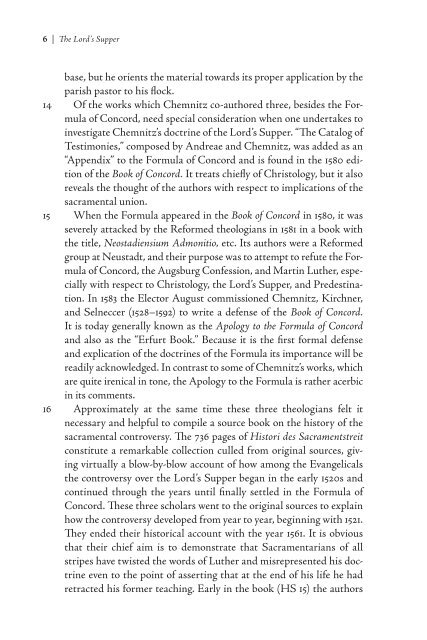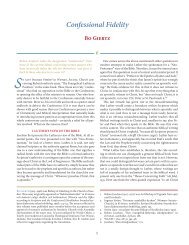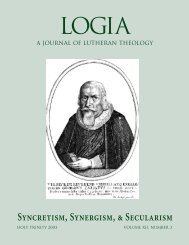The Lord's Supper in the Theology of Martin Chemnitz Bjarne - Logia
The Lord's Supper in the Theology of Martin Chemnitz Bjarne - Logia
The Lord's Supper in the Theology of Martin Chemnitz Bjarne - Logia
You also want an ePaper? Increase the reach of your titles
YUMPU automatically turns print PDFs into web optimized ePapers that Google loves.
| <strong>The</strong> Lord’s <strong>Supper</strong><br />
base, but he orients <strong>the</strong> material towards its proper application by <strong>the</strong><br />
parish pastor to his flock.<br />
14 Of <strong>the</strong> works which <strong>Chemnitz</strong> co-authored three, besides <strong>the</strong> Formula<br />
<strong>of</strong> Concord, need special consideration when one undertakes to<br />
<strong>in</strong>vestigate <strong>Chemnitz</strong>’s doctr<strong>in</strong>e <strong>of</strong> <strong>the</strong> Lord’s <strong>Supper</strong>. “<strong>The</strong> Catalog <strong>of</strong><br />
Testimonies,” composed by Andreae and <strong>Chemnitz</strong>, was added as an<br />
“Appendix” to <strong>the</strong> Formula <strong>of</strong> Concord and is found <strong>in</strong> <strong>the</strong> 1580 edition<br />
<strong>of</strong> <strong>the</strong> Book <strong>of</strong> Concord. It treats chiefly <strong>of</strong> Christology, but it also<br />
reveals <strong>the</strong> thought <strong>of</strong> <strong>the</strong> authors with respect to implications <strong>of</strong> <strong>the</strong><br />
sacramental union.<br />
15 When <strong>the</strong> Formula appeared <strong>in</strong> <strong>the</strong> Book <strong>of</strong> Concord <strong>in</strong> 1580, it was<br />
severely attacked by <strong>the</strong> Reformed <strong>the</strong>ologians <strong>in</strong> 1581 <strong>in</strong> a book with<br />
<strong>the</strong> title, Neostadiensium Admonitio, etc. Its authors were a Reformed<br />
group at Neustadt, and <strong>the</strong>ir purpose was to attempt to refute <strong>the</strong> Formula<br />
<strong>of</strong> Concord, <strong>the</strong> Augsburg Confession, and Mart<strong>in</strong> Lu<strong>the</strong>r, especially<br />
with respect to Christology, <strong>the</strong> Lord’s <strong>Supper</strong>, and Predest<strong>in</strong>ation.<br />
In 1583 <strong>the</strong> Elector August commissioned <strong>Chemnitz</strong>, Kirchner,<br />
and Selneccer (1528–1592) to write a defense <strong>of</strong> <strong>the</strong> Book <strong>of</strong> Concord.<br />
It is today generally known as <strong>the</strong> Apology to <strong>the</strong> Formula <strong>of</strong> Concord<br />
and also as <strong>the</strong> “Erfurt Book.” Because it is <strong>the</strong> first formal defense<br />
and explication <strong>of</strong> <strong>the</strong> doctr<strong>in</strong>es <strong>of</strong> <strong>the</strong> Formula its importance will be<br />
readily acknowledged. In contrast to some <strong>of</strong> <strong>Chemnitz</strong>’s works, which<br />
are quite irenical <strong>in</strong> tone, <strong>the</strong> Apology to <strong>the</strong> Formula is ra<strong>the</strong>r acerbic<br />
<strong>in</strong> its comments.<br />
16 Approximately at <strong>the</strong> same time <strong>the</strong>se three <strong>the</strong>ologians felt it<br />
necessary and helpful to compile a source book on <strong>the</strong> history <strong>of</strong> <strong>the</strong><br />
sacramental controversy. <strong>The</strong> 736 pages <strong>of</strong> Histori des Sacramentstreit<br />
constitute a remarkable collection culled from orig<strong>in</strong>al sources, giv<strong>in</strong>g<br />
virtually a blow-by-blow account <strong>of</strong> how among <strong>the</strong> Evangelicals<br />
<strong>the</strong> controversy over <strong>the</strong> Lord’s <strong>Supper</strong> began <strong>in</strong> <strong>the</strong> early 1520s and<br />
cont<strong>in</strong>ued through <strong>the</strong> years until f<strong>in</strong>ally settled <strong>in</strong> <strong>the</strong> Formula <strong>of</strong><br />
Concord. <strong>The</strong>se three scholars went to <strong>the</strong> orig<strong>in</strong>al sources to expla<strong>in</strong><br />
how <strong>the</strong> controversy developed from year to year, beg<strong>in</strong>n<strong>in</strong>g with 1521.<br />
<strong>The</strong>y ended <strong>the</strong>ir historical account with <strong>the</strong> year 1561. It is obvious<br />
that <strong>the</strong>ir chief aim is to demonstrate that Sacramentarians <strong>of</strong> all<br />
stripes have twisted <strong>the</strong> words <strong>of</strong> Lu<strong>the</strong>r and misrepresented his doctr<strong>in</strong>e<br />
even to <strong>the</strong> po<strong>in</strong>t <strong>of</strong> assert<strong>in</strong>g that at <strong>the</strong> end <strong>of</strong> his life he had<br />
retracted his former teach<strong>in</strong>g. Early <strong>in</strong> <strong>the</strong> book (HS 15) <strong>the</strong> authors




